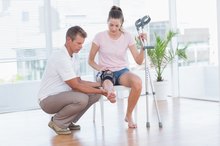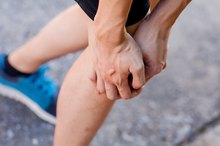Despite the name making it sound like a simple bruise, a bone bruise is a lot more painful and the pain lasts longer than the giant swelling of a bruise on the skin or in the muscle.
In fact, it's one step before a bone fracture. Here's what you need to know about bone bruises 5.
How Does a Bone Bruise Happen?
Bones are composed of a network of fibers that help retain calcium, a mineral in the body that keeps bones healthy and strong. If a bone is damaged extensively enough, many of these tiny fibers will break, resulting in a fracture. A bone bruise occurs when only a few of the fibers break.
This condition, which is also called a periosteal hematoma, occurs when the outer layer of a bone, called the cortex, sustains small breaks following injury or trauma 12. If you're taking medication that thins your blood, you may be at greater risk for bone bruises.
Read more: 10 Common Workout Injuries and How to Avoid Them
- Bones are composed of a network of fibers that help retain calcium, a mineral in the body that keeps bones healthy and strong.
- If a bone is damaged extensively enough, many of these tiny fibers will break, resulting in a fracture.
Bone Bruise Symptoms
Femoral Bone Contusions & Stretching
Learn More
- When the shoulder is affected, your range of motion can be limited and weakness may be present. This makes activities like bathing and dressing quite challenging.
- Bone bruising in the knee or shin can lead to difficulty with walking and balance 12. Stiffness with bending or straightening the knee may also occur.
- If the ankle or foot are affected, standing and walking are often extremely painful and crutches may be necessary to assist with your mobility. In addition, swelling may develop below the injured area in the forefoot or toes. * Bruising to the tailbone causes pain with sitting, particularly on hard surfaces, and can limit your ability to ride in a car.  10; :
-
- When the shoulder is affected, your range of motion can be limited and weakness may be present.
- When the shoulder is affected, your range of motion can be limited and weakness may be present.
- Stiffness with bending or straightening the knee may also occur. * If the ankle or foot are affected, standing and walking are often extremely painful and crutches may be necessary to assist with your mobility.
How Do You Diagnose a Bone Bruise?
The most common way to diagnose a bone bruise is to get an MRI. This method of imaging enables you to assess the amount of damage to the bone and the layers that have been affected.
In addition, it allows your physician to see the bleeding and swelling that can occur in the area. While an x-ray can help to rule out a fracture, it is not useful when looking for a bone bruise (see reference 3, section 1).
Bone Bruise vs. Muscle or Skin Bruise
How to Care for a Bruised Knee
Learn More
It can be tricky to differentiate between a run-of-the-mill bruise on your muscle or skin and a deeper bone bruise. Typically the symptoms of a bone bruise stick around much longer than one on your skin or muscle and are the result of a more significant trauma or injury.
In addition, bone bruises typically lead to significant swelling which in turn can cause stiffness in nearby joints. On the contrary, muscle or skin bruises heal more rapidly and usually don't affect your mobility as greatly.
- It can be tricky to differentiate between a run-of-the-mill bruise on your muscle or skin and a deeper bone bruise.
- Typically the symptoms of a bone bruise stick around much longer than one on your skin or muscle and are the result of a more significant trauma or injury.
Bone Bruise vs. Fracture
Since both bone bruises and fractures can result from similar trauma, it's important to know which one you're dealing with 4. The pain from fractures tends to be sharper in nature while bone bruises may cause a deeper, more achy type of pain.
In addition, feelings of instability and even visible deformities in the skin can accompany a fracture while these usually aren't seen with a bruise. Because these two serious conditions are commonly confused, it is important to see your doctor if you are experiencing any of the symptoms above so that you can be properly diagnosed and treated.
- Since both bone bruises and fractures.
- In addition, feelings of instability and even visible deformities in the skin can accompany a fracture while these usually aren't seen with a bruise.
- **
- It can be tricky to differentiate between a run-of-the-mill bruise on your muscle or skin and a deeper bone bruise.
- In addition, feelings of instability and even visible deformities in the skin can accompany a fracture while these usually aren't seen with a bruise.
Bone Bruise Treatments
Immediately after injury, apply an ice pack to the area to reduce pain and swelling. An ice pack can be applied over a wet towel for 10 to 15 minutes every 3 to 4 hours. Ice is typically used for 2 to 3 days after injury or until swelling has subsided.
Thereafter, heat can be applied to decrease pain and promote healing. Heat is typically applied for 15 to 20 minutes at a time for 3 to 4 days. Place a towel between your skin and the heat source (heat pack or hot water bottle) to reduce the risk of burns.
Other important treatments are to rest and elevate the injured area as much as possible, as well as take an over the counter anti-inflammatory pain medication such as ibuprofen (Advil, Motrin) or naproxen (Aleve). Resting allows the body to generate new bone tissue without stressing the injured area.
Depending on the severity, patients may continue light activity wearing a splint, elastic bandage or athletic tape, while more severe cases may need crutches or a sling to prevent any more damage and allow for healing.
Read more: 5 Surprising Foods to Eat for Strong Bones
- Immediately after injury, apply an ice pack to the area to reduce pain and swelling.
- Depending on the severity, patients may continue light activity wearing a splint, elastic bandage or athletic tape, while more severe cases may need crutches or a sling to prevent any more damage and allow for healing.
When Should I Go to a Doctor for a Bone Bruise?
- You don’t see improvement, or if swelling increases, after 3 or 4 days of icing, resting and anti-inflammatory pain medication.
- If you have pain while stretching or bearing weight in either leg.
- If the skin is pale and cool below the injury.
:
What Do YOU Think?
Have you ever had a bone bruise 567? Or fractured a bone? What did you do 5? What did your doctor tell you 7? What kinds of treatments helped you heal? Share your stories and questions in the comments below!
- Have you ever had a bone bruise 5?
Related Articles
References
- University of Rochester Medical Center: What is a bone bruise?
- International Cartilage Regeneration and Joint Preservation Society: Are Bone Bruise Characteristics and Articular Cartilage Pathology Associated with Inferior Outcomes 2 and 6 Years After Anterior Cruciate Ligament Reconstruction?
- Epocrates: Long Bone Fractures: Differential Diagnosis
- Medical News Today: Bone Bruise: What You Need to Know
- St Luke's Kansas City: How Do you Diagnose a Bone Bruise?
- Healthline: Bone Bruise: When Should You See Your Doctor?
- Cartilage: Are Bone Bruise Characteristics and Articular Cartilage Pathology Associated with Inferior Outcomes 2 and 6 Years After Anterior Cruciate Ligament Reconstruction?
- MD Health: Bone Bruises: Types, Causes, and Treatments
- Web MD: Tailbone (Coccyx) Injury
- ePain Assist: Shoulder Joint Bruises: Types, Causes, Treatment, Symptoms, Prevention
- Physio.co.uk: Bone Bruising of the Tibia
- Uçar BY, Necmioğlu S, Bulut M, Azboy I, Demirtaş A, Gümüş H. Determining bone bruises of the knee with magnetic resonance imaging. Open Orthop J. 2012;6:464–467. doi:10.2174/1874325001206010464
- Mandalia V, Henson JH. Traumatic bone bruising--a review article. Eur J Radiol. 2008;67(1):54-61. doi:10.1016/j.ejrad.2008.01.060
- Wildi LM, Raynauld J-P, Martel-Pelletier J, Abram F, Dorais M, Pelletier J-P. Relationship between bone marrow lesions, cartilage loss and pain in knee osteoarthritis: results from a randomised controlled clinical trial using MRI. Annals of the Rheumatic Diseases. 2010;69(12):2118-2124. doi:10.1136/ard.2009.127993
- Marcacci M, Andriolo L, Kon E, Shabshin N, Filardo G. Aetiology and pathogenesis of bone marrow lesions and osteonecrosis of the knee. EFORT Open Rev. 2017;1(5):219–224. Published 2017 Mar 13. doi:10.1302/2058-5241.1.000044
- Boks SS, Vroegindeweij D, Koes BW, Bernsen RMD, Hunink MGM, Bierma-Zeinstra SMA. MRI Follow-Up of Posttraumatic Bone Bruises of the Knee in General Practice. American Journal of Roentgenology. 2007;189(3):556-562.
- Boks SS, Vroegindeweij D, Koes BW, Bernsen RMD, Hunink MGM, Bierma-Zeinstra SMA. MRI Follow-Up of Posttraumatic Bone Bruises of the Knee in General Practice. American Journal of Roentgenology. 2007;189(3):556-562.
- Mandalia V, Henson J. Traumatic bone bruising—A review article. European Journal of Radiology. 2008;67(1):54-61.
- Marcacci M, Andriolo L, Kon E, Shabshin N, Filardo G. Aetiology and pathogenesis of bone marrow lesions and osteonecrosis of the knee. EFORT Open Rev. 2017;1(5):219–224. Published 2017 Mar 13.
- Uçar BY, Necmioğlu S, Bulut M, Azboy I, Demirtaş A, Gümüş H. Determining bone bruises of the knee with magnetic resonance imaging. Open Orthop J. 2012;6:464–467. doi:10.2174/1874325001206010464
- Wildi LM, Raynauld J-P, Martel-Pelletier J, Abram F, Dorais M, Pelletier J-P. Relationship between bone marrow lesions, cartilage loss and pain in knee osteoarthritis: results from a randomised controlled clinical trial using MRI. Annals of the Rheumatic Diseases. 2010;69(12):2118-2124. doi:10.1136/ard.2009.127993.
Writer Bio
Sharon Brock, MS, is a content editor for LIVESTRONG.COM with a focus on health. Brock was previously the lead editor for two medical publications at USC medical center. She was pre-med as an undergraduate and earned a master's degree in journalism from Columbia University. You can find Brock's work in several publications, including Yoga Journal, 7x7, New You and Healthline.com.







